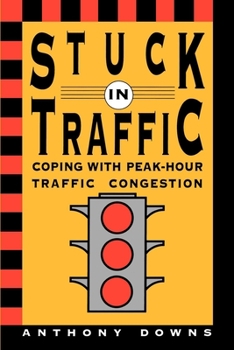Stuck in Traffic: Coping with Peak-Hour Traffic Congestion
Select Format
Select Condition 
Book Overview
"A Brookings Institution Press and Lincoln Institute of Land Policy publication Peak-hour traffic congestion has become a major problem in most U.S. cities. In fact, a majority of residents in metropolitan and suburban areas consider congestion their most serious local problem. As citizens have become increasingly frustrated by repeated traffic delays that cost them money and waste time, congestion has become an important factor affecting local...
Format:Paperback
Language:English
ISBN:081571923X
ISBN13:9780815719236
Release Date:June 1992
Publisher:Globe Pequot Publishing Group Inc/Bloomsbury
Length:224 Pages
Weight:0.85 lbs.
Dimensions:0.3" x 6.1" x 9.0"
Customer Reviews
2 ratings
puncturing illusions
Published by Thriftbooks.com User , 22 years ago
This book rebuts both environmentalists and road lobbyists, by explaining why neither expanded transit nor expanded roads will have significant impacts upon congestion: expanded transit is of minimal value because it affects so few people (except perhaps in downtowns), expanded roads don't work because of what Downs calls "triple convergence" -- when a road is built it fills up because (1) drivers who used alternative routes switch to the new or widened road, (2) drivers who avoided rush hour start traveling during rush hour, and (3) drivers who used public transit switch to the improved expressway. (And triple convergence doesn't even take into account the long-run congestion that results when people move to be near a widened or new expressway, thus causing additional ridership increases). The only solution is to reduce demand for transportation, by encouraging ride sharing through tolls, fuel tax increases and other unpopular steps. In short, the most effective ways of reducing congestion are also the least politically popular.
Downs Explains How Hard it is to Reduce Traffic Congestion
Published by Thriftbooks.com User , 24 years ago
I have used Anthony Downs, "Stuck in Traffic" for three years for a short course in urban transportation planning. Students find it clear and yet realistic on how simplistic solutions like "building more highway lanes" have unintended consequences that cancel out the gains.He also looks at urban planning solutions, and shows that some gains might occur from increasing housing densities from very low to low or moderate, but most other solutions have little effect. Finally, the most powerful solutions, including higher gasoline taxes, increased public funding for transit, and tolling on highways are also the least palatable politically.Downs, an economist, is strong on the economic aspects of transportation, and has a good grasp on the planning issues. The book does not cover any of the engineering details of possible schemes.Overall, an clearly written and strongly argued book.Jim Mars School of Urban and Regional Planning Ryerson Polytechnic University Toronto, Ontario, CANADA





